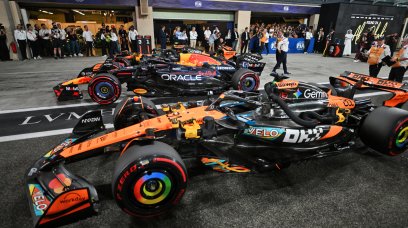Nine of the 10 F1 teams have begun a group test of the new 18-inch wheels and tyres that will be introduced to F1 in 2022. The two-day test concludes track time in 2021, and is being run in parallel with F1's Young Driver Test at the Yas Marina Circuit. It's led to a very rare situation, as the test has seen the return of the 2018 cars - the teams have created 'mule' cars from them, with modified aerodynamics, suspension and brakes in order to run the bigger wheels. While Formula 2 made the switch to 18-inch wheels in 2021, F1's planned switch was postponed as part of the wider regulation postponement when the COVID-19 pandemic struck in 2020. However, after running individual team tests throughout this year with their mule cars, Abu Dhabi is playing host to a group test this week. Williams are the only outfit not taking part in the test due to not constructing a mule car for use by Pirelli. However, all acquired data will be shared out equally across the teams.
Why the change?
It's a move that's been coming for a while now, and that is a shift away from the traditional 13-inch wheel that has been a mainstay in Formula 1 for more than 30 years. Aside from the improved aesthetics of bigger wheels, the relevance towards road car technology is far greater. Pirelli's new 18-inch tyres, which are reaching the conclusion of the initial development test programme for F1 as well as already being in use in Formula 2, will run the same tread width as now, but with a bigger diameter. The sidewall reduction will be the biggest change, more closely resembling a road car. The changed behaviour of the tyre means the cars will handle differently, making them more precise due to the far stiffer sidewall. Testing so far has only resulted in positive driver feedback, with less tyre flex and less impact on car aerodynamics. This increased stability means less focus is required from the teams to address the turbulence, meaning lower costs. Aside from the wheels themselves, wheel covers return for the first time since 2009. This is done to reduce the aerodynamic wake coming off the cars, for the benefit of those behind. However, it also reduces the downforce of the car itself. The physical seal of a wheel cover prevents the teams from finding ways of redirecting air through the wheels. Over wheel winglets are also set to be introduced, something that has never been seen in F1 before. These will help to direct the wake of the air coming off the front wheels and away from the rear wing.
How to tell the compounds apart
For the compounds being used in testing, the tyre with a white livery and no brackets is the hardest compound, the C1. The C2 is also white, but includes extra white brackets. Teams will be given two sets of the C1 and C2 compounds over the two days. The C3 will be yellow-marked, with four sets of the mid-range tyre given to the teams. The red-marked C4 tyres will be the most plentiful for the teams to choose from, as they are given six sets for the two days. Finally, the C5 red-marked softest tyres will display no brackets, and teams will be given four sets each.
1470390467489632262
We’re bringing all the #Fit4F1 compounds to the Abu Dhabi post-season test. Here’s how to tell the 🍩 apart. 👇 #F1 #Formula1 #Pirelli #Turning18 #F1202 pic.twitter.com/2UCHbcTFm3 — Pirelli Motorsport (@pirellisport) December 13, 2021
1470670151955664899
Day 1 of post-season testing at @ymcofficial is underway: we have @F1 drivers testing 2022 #Fit4F1 18-inch tyres with mule cars and young drivers with 13-inch tyres. pic.twitter.com/3Hk6JjLkIu — Pirelli Motorsport (@pirellisport) December 14, 2021
Most read








